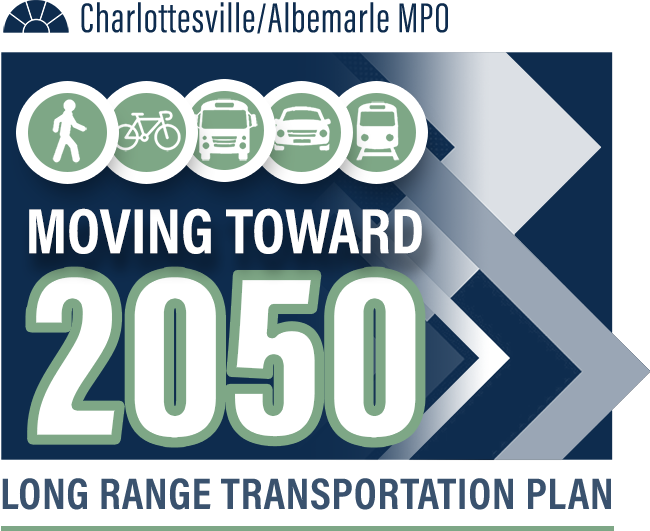Public Comment
Review and Comment on the CA-MPO’s Long-Range Transportation Plan, Moving Toward 2050
Please submit your comments and feedback on the draft CA-MPO Long-Range Transportation Plan, Moving Toward 2050 using the comment form
What is Moving Toward 2050?
Moving Toward 2050 is the federally-required long range transportation plan (LRTP) for the City of Charlottesville and urbanized portions of Albemarle County, which is the area served by the Charlottesville-Albemarle Metropolitan Planning Organization (CA-MPO). This plan, to be reviewed and adopted by the CA-MPO Policy Board, identifies long range transportation needs, considers possible infrastructure improvements, and establishes priorities to implement projects based on anticipated funding.
Why should I care about the plan?
Transportation is essential to all of us. From jobs to goods to the people we care about and the places that bring us joy, transportation connects us to what we need.
The Moving Toward 2050 planning process works to address questions such as:
As a user of the transportation system, you are directly impacted by the decisions that are made around which infrastructure projects are pursued. Therefore, it is important that your opinions are reflected in determining how projects should be prioritized.


What does the plan do?
Moving Toward 2050 considers systemwide needs across all modes of transportation and establishes priorities for how transportation funding opportunities should be leveraged. It will consider factors that are important to the community including:
The LRTP must cover a planning-horizon of at least 20 years and is updated every five years to reflect changes in demographics, land use, travel patterns, and growth projections. CA-MPO’s previous LRTP was adopted May 22, 2019 and used 2045 as its future planning year. This next LRTP will use a future planning year of 2050 and is scheduled to be presented to the Policy Board for adoption during its regular meeting in May 2024. The final outcome of this plan will be a list of prioritized projects based on estimated benefits relative to cost, recommended implementation strategies, and prioritized needs requiring further evaluation.
Why is Moving Toward 2050 important?
1. To be eligible for federal funding
2. Funding for transportation system improvements is limited
3. Funding for transportation system improvements is competitive
4. Transportation planning is an ongoing process
How can I get involved?
Stay Informed
MPO staff will be conducting broad public engagement in the spring and summer. Sign up for our mailing list to receive updates and make sure you’re in the know.
Related Documents and Resources
Past Events
Event #1
Virtual Public Meeting
June 20, 2023
Event #2
Moving Toward 2050 Open House
June 21, 2023
Event #3
Moving Toward 2050 Open House
March 7, 2024
TJPDC fully complies with Title VI of the Civil Rights Act of 1964 in all programs and activities. TJPDC provides reasonable accommodations for persons who require special assistance to participate in public involvement opportunities. For more information, to request translation services or other accommodations, or to obtain a Discrimination Complaint Form, contact (434) 979-7310 or www.tjpdc.org.
Project Timeline
Phase I: Data Collection and Analysis
Late 2022 – Early 2023- Gather Data
- Track trends
- Development of Project Website
Phase II: Goal-setting and Needs Identification
Spring-Summer 2023- Develop goals and objectives
- Identify and Prioritize Transportation System Needs
- Prioritize Goals and Set Performance Measures
- First Round of Stakeholder Discussions
- Regional Survey
- Public Intercepts
- Second Round of Stakeholder Discussions
- Public Engagement Report
Phase III: Defining Solutions
Fall-Winter 2023- Develop Solutions
- Identify Projects
- Prioritize Projects
- Open House
Active Phase
Phase IV: Plan Development and Adoption
Winter-Spring 2024- Develop the Plan Document
- Conduct Plan Review
- Adopt the Plan
- Open House
- Webinar
- Public Intercepts
- MPO Public Hearings
Phase V: Plan Maintenance
Ongoing- Apply for project funding
- Update the Plan as needed
- Conduct regular plan reviews

